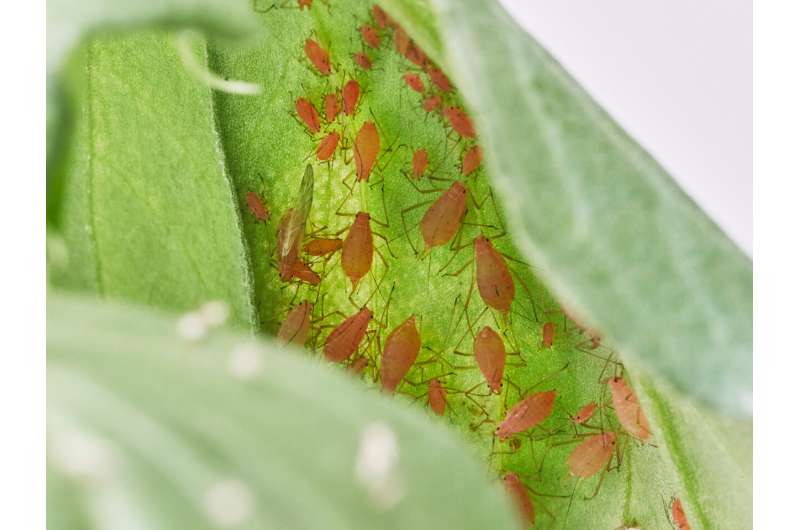Catnip and pea aphids came up with different ways to make the same molecule

In a new study in PNAS, a research team at the Max Planck Institute for Chemical Ecology in Jena, Germany, shows that both catnip and pea aphids produce the substance nepetalactone, even though the plant and the insect evolved the biosynthesis of this iridoid independently.
Although the individual biosynthetic steps are identical, the enzymes that catalyze them are different in the plant and the aphid. This is the first time that researchers have been able to elucidate the biosynthetic pathway of such a complex molecule as nepetalactone in an animal.
Iridoids: Complex molecules with different ecological functions
Iridoids, a group of monoterpenes, are usually referred to as secondary plant metabolites, as they are found widely in many plant species. Their name is derived from the ant genus Iridomyrmex and its defensive secretions. In plants, their role is primarily to defend against herbivores or protect from pathogens. Iridoids have been found in more than 50 plant families.
In previous work, Sarah O'Connor and her team presented the evolutionary origins of the iridoid nepetalactone in catnip. "We were able to show how catnip produces this complex compound. However, it has been known since the 1980s that female aphids also produce nepetalactone and use it as a sex pheromone. We therefore wanted to find out how aphids make this natural compound and compare the biosynthetic pathways in plants and insects. Another incentive was that we have an expert on aphids at our institute, Grit Kunert," says Sarah O'Connor, head of the Department of Natural Product Biosynthesis, describing the motivation for the research project.
Natural products from insects: Neglected in research so far
To determine the genes that regulate nepetalactone production in aphids, the researchers "harvested" legs from aphids, because the pheromone nepetalactone is produced exclusively in the hind legs of sexual females. They also extracted RNA, which provides the basic information for protein biosynthesis, from corresponding tissue in hind legs of sexual and asexual females and males, and in front legs of sexual females.
"We then subjected each one of these RNA samples to gene sequencing and looked more closely at these gene sequences to identify genes that were active exclusively in the hind legs of sexual females. Only a very small number of genes fell into this category, so it was a very streamlined process to find the genes responsible for nepetalactone biosynthesis in aphids," says Tobias Köllner, first author of the study.
Using this approach, the researchers were able to identify the enzymes for nepetalactone biosynthesis and thus the entire biosynthetic pathway. Surprisingly, while the intermediates in the biosynthetic pathway were identical in catnip and aphid, the six identified aphid enzymes that catalyze the intermediate steps were completely different to their counterparts in catnip. "While the plant enzymes for nepetalactone biosynthesis are all soluble, most of the insect enzymes are associated with a membrane," Tobias Köllner says.
The biosynthetic pathway of the sex pheromone nepetalactone in the pea aphid, which is described in this study, is one of the longest and chemically most complex biosynthetic pathways for insect-derived natural products ever reported. This is partly because insect-derived natural products have been rather neglected in research to date. "I think that in the past, sequencing very small amounts of RNA—such as the amounts isolated from tiny aphid legs—has been challenging. With new and better sequencing techniques, we now have the ability to get high-quality sequence data from hard-to-obtain tissues," says Sarah O'Connor.
Convergent evolution across the borders of the plant and animal kingdoms
The comparison of iridoid biosynthetic pathways in plants and insects made possible by this study is particularly interesting. The fact that different organisms developed similar solutions independently of each other is called "convergent evolution." A well-known example is the ability to fly, which evolved in both birds and mammals (bats). Here, researchers report on the convergent evolution of metabolic enzymes in insects and plants, which—although different and independently evolved—mediate complex biochemical processes resulting in the formation of the same chemical compound.
Since many other insects also produce iridoids, the researchers led by Tobias Köllner and Sarah O'Connor would like to combine knowledge about biosynthesis with the role that iridoids play in insects. The interdisciplinary collaboration with colleagues at the institute and their entomological expertise will help to better understand the biological, ecological and behavioral basis of these natural products from insects.
More information: Köllner, Tobias G. et al, Biosynthesis of iridoid sex pheromones in aphids, Proceedings of the National Academy of Sciences (2022). DOI: 10.1073/pnas.2211254119. doi.org/10.1073/pnas.2211254119
Journal information: Proceedings of the National Academy of Sciences
Provided by Max Planck Society




















